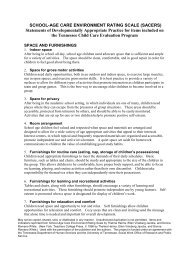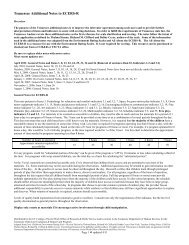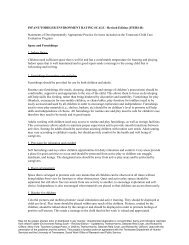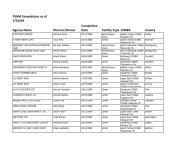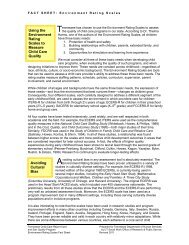Tennessee Additional Notes to SACERS Page 1 Updated 7/10
Tennessee Additional Notes to SACERS Page 1 Updated 7/10
Tennessee Additional Notes to SACERS Page 1 Updated 7/10
- No tags were found...
Create successful ePaper yourself
Turn your PDF publications into a flip-book with our unique Google optimized e-Paper software.
<strong>Tennessee</strong> <strong>Additional</strong> <strong>Notes</strong> <strong>to</strong> <strong>SACERS</strong>OverviewThe purpose of the <strong>Tennessee</strong> additional notes is <strong>to</strong> improve the interrater agreements of assessors, and <strong>to</strong> provide further interpretation of itemsand indica<strong>to</strong>rs <strong>to</strong> assist with scoring decisions by <strong>Tennessee</strong> Assessment Program Staff (APS). Thelma Harms, Ellen Vineberg Jacobs andDonna Romano White, authors of the scale developed the notes without dates or with reference in parenthesis <strong>to</strong> North Carolina. These noteshave been adopted for use in <strong>Tennessee</strong> assessments. Some of the information used in the additional notes was adapted from the EnvironmentRating Scales.Be sure <strong>to</strong> replace older notes with newer notes.The most recent TN updates are:7/<strong>10</strong>: General <strong>Notes</strong> and Item 37<strong>10</strong>/09: General <strong>Notes</strong>, Items 2, 15, 18, 23, 26 and 28 (Some General <strong>Notes</strong> have been moved directly under the items)5/1/09: General <strong>Notes</strong>, Items 2, 3, 5, 8, 18, 23, 26, 27and 404/28/08: General <strong>Notes</strong>, Items 22, 23, 26, 371/1/2008: General <strong>Notes</strong>, Item 7, 444/30/07: General <strong>Notes</strong>11/1/06: No revisionsGeneral <strong>Notes</strong> for <strong>SACERS</strong>In all items involving any type of interaction, “staff” refers <strong>to</strong> those adults who are in the classroom and who work with the children daily (oralmost daily), for a substantial part of the day. This can include volunteers, if they are in the classroom for the required amount of time. Adultswho are in the classroom for short periods of the day, or who are not a regular daily part of the classroom, do not count in evaluating whether therequirements of the item are met. For example, if a therapist, parent, a direc<strong>to</strong>r, or owner of a program comes in<strong>to</strong> the classroom and interactswith children, for short or irregular periods, these interactions do not count in scoring the item.The term “some” occurs most frequently in indica<strong>to</strong>rs that represent a minimal (3) level of quality, although occasionally it occurs at higherlevels. In determining how much is needed <strong>to</strong> give credit for “some” in an indica<strong>to</strong>r, consider the requirements in the parallel indica<strong>to</strong>rs at thelower and next higher level of quality. For example, if under inadequate “no” materials are required, then “some” would mean “one or more”.In cases where a plural is used with the term “some”, then “more than one” would be required <strong>to</strong> give credit. When terms such as “very few” or“very little” or “rarely” are used under inadequate, then “some” represents a mid-point between what is required for the 1 and the 5 levels.At the three level, materials are considered accessible only if it is observed that children freely access and are permitted <strong>to</strong> use most of thematerials. Ex. Some centers may not be opened during the observation. If the schedule indicates an additional time for access <strong>to</strong> materials, basescore on teacher questions and how materials were used. At the five level, materials must be accessible for one third of the day. A ten minutevariance is allowed. For both levels of quality, another determining fac<strong>to</strong>r when deciding accessibility as opposed <strong>to</strong> availability is who initiatesgetting the materials. If the teacher initiates putting the materials out, they are accessible for the period of time they are out. If children initiateby asking for materials then they are not considered accessible but are available. For all programs, regardless of the hours of operation,throughout the day requires that all children benefit from meaningful periods of play. Full day programs (8 hours or more) mustprovide multiple opportunities for free play during times when the majority of the children could have access. In after school programs,the schedule should reflect at least one meaningful period when the majority of children have access <strong>to</strong> materials because they havebeen in large group, structured activities for much of the school day. In programs that choose <strong>to</strong> provide extensive periods of outdoorplay, the provider has an additional responsibility <strong>to</strong> provide access <strong>to</strong> various materials while outdoors so that children may still havesignificant opportunities <strong>to</strong> explore and discover. When rotation of materials is required, rotation should occur monthly.Levels of quality build expectations from minimal <strong>to</strong> good <strong>to</strong> excellent. Consider not only the requirements of the indica<strong>to</strong>r, but the level ofquality documented as general practice throughout the observation.The requirement for materials <strong>to</strong> be accessible for 1/3 day at the good level pertains <strong>to</strong> the following items and indica<strong>to</strong>rs: Items 3, Space forprivacy-indica<strong>to</strong>r 5.1; 7, Furnishings for relaxation and comfort-indica<strong>to</strong>r 5.1; 20, Arts and crafts-indica<strong>to</strong>r 5.1; 21, Music and movementindica<strong>to</strong>r5.2; 22, Blocks and construction-indica<strong>to</strong>r 5.1; 23, Drama/theater-indica<strong>to</strong>r 5.1; 24, Language/reading activities-indica<strong>to</strong>r 5.1; 25,Math/reasoning activities-indica<strong>to</strong>r 5.1; 26, Science/nature activities-indica<strong>to</strong>r 5.1; 27, Cultural awareness-indica<strong>to</strong>r 5.1.When two or more teachers are in the classroom and you are trying <strong>to</strong> determine overall impact of interactions, look for a balance. However, ifone caregiver is extremely negative, a balance cannot be achieved and the indica<strong>to</strong>r should be discounted.Distributed by the UT College of Social Work Office of Research & Public Service under contract <strong>to</strong> the <strong>Tennessee</strong> Department of Human Services for the<strong>Tennessee</strong> Child Care Evaluation & Report Card Program.Adapted from School-Age Care Rating Scale, by Thelma Harms, Ellen Vineberg Jacobs, and Donna Romano White. (New York: Teachers College Press, ©1996by Thelma Harms, Ellen Vineberg Jacobs, and Donna Romano White.) Used with permission of the publisher and the authors. All rights reserved. This project isfunded under an agreement with the <strong>Tennessee</strong> Department of Human Services and the University of <strong>Tennessee</strong>, Social Work Office ofResearch and Policy Services.<strong>Page</strong> 1 <strong>Updated</strong> 7/<strong>10</strong>
<strong>Tennessee</strong> <strong>Additional</strong> <strong>Notes</strong> <strong>to</strong> <strong>SACERS</strong>For children under the age of <strong>10</strong>, staff must be able <strong>to</strong> hear the child at all times, must be able <strong>to</strong> see the child with a quick glance, and must beable <strong>to</strong> physically respond immediately, leaving no child unattended. For children <strong>10</strong> and older, the adult must know the whereabouts andactivities of the children at all times and must be able <strong>to</strong> physically respond immediately.For all scales-the presence of weapons or characters displaying weapons is no longer an au<strong>to</strong>matic discount. With regard <strong>to</strong> books, pictures, andmaterials, if the combined, overall impact is negative, displays graphic violence, and promotes aggressive behavior such as play fighting that isnot s<strong>to</strong>pped by the caregiver, then discounting is valid and should be well documented in the assessor notes.Disinfectant and/or anti-bacterial wipes do not count for sanitization purposes. Products that can be given credit as sanitizing solutions are:bleach and water solution; or a commercial product that states on the label or manufacturer’s products sheet it kills 99.9% of germs, kills HIVvirus, or is an EPA registered product. All commercial products used for sanitizing must be used according <strong>to</strong> manufacturer’s instruction.Display should be meaningful for children. To meet the requirements of the display indica<strong>to</strong>rs as well as the requirements of otheragencies, consider the quality of the display. The requirements may be met with fewer thoughtfully chosen pieces that incorporateseveral meaningful components (ex. one poster may include diversity and current themes, etc.).The following indica<strong>to</strong>rs are connected indica<strong>to</strong>rs. When credit is not given for the first indica<strong>to</strong>r, credit cannot be given for the secondindica<strong>to</strong>r: 4/3.1 and 3.3Items <strong>to</strong> be omitted from TN scoring: #9, #<strong>10</strong>, #11, #12, #14, #36, #39, #41, #42, #43, #45, #46, #47, #48, and #49Specific <strong>Notes</strong> for <strong>SACERS</strong>1. Indoor space1.3 Score Yes only when space is in very poor repair.3.3 Score Yes when space is generally in good repair; do not penalize for small problems.5.3 This indica<strong>to</strong>r considers ongoing maintenance as well as housekeeping. (TN 7/20/01)2. Space for gross mo<strong>to</strong>r activities1.2 Add “completely” so indica<strong>to</strong>r reads “Outdoor space completely lacks protection . . .”3.1, 5.1, 7.1 Some space used for gross mo<strong>to</strong>r activity should be accessible daily.5.2 Requires at least three different surfaces. Determine whether the surfaces in the outdoor space enable children <strong>to</strong> successfully participatein different types of play. For example, each different surface must be large enough <strong>to</strong> permit a type of play without much interruption fromother activities. At least one hard and one soft play surface must be accessible daily outdoors. If there is no equipment present, which requiresresilient surfacing, the requirements of this indica<strong>to</strong>r can be met with just two surfaces (one hard, one soft).7.2 Age groups = K-3, 4-6, or older. N/A if all children are in the same age group.7.3 Since this indica<strong>to</strong>r is at the 7 level, the playground should be fairly close. Take the age of the children in<strong>to</strong> consideration. “Convenient”includes more than close (e.g., on same level).3. Space for privacyNo score of 2 is possible.5.2 This space must be accessible <strong>to</strong> the children.4. Room arrangement1.2 Replace “rooms” with “space”, so indica<strong>to</strong>r reads, “Space inconveniently arranged . . .”Omit all of #4a ("When doing homework is part of the program").Add the following indica<strong>to</strong>rs <strong>to</strong> #4 ("Room arrangement").Distributed by the UT College of Social Work Office of Research & Public Service under contract <strong>to</strong> the <strong>Tennessee</strong> Department of Human Services for the<strong>Tennessee</strong> Child Care Evaluation & Report Card Program.Adapted from School-Age Care Rating Scale, by Thelma Harms, Ellen Vineberg Jacobs, and Donna Romano White. (New York: Teachers College Press, ©1996by Thelma Harms, Ellen Vineberg Jacobs, and Donna Romano White.) Used with permission of the publisher and the authors. All rights reserved. This project isfunded under an agreement with the <strong>Tennessee</strong> Department of Human Services and the University of <strong>Tennessee</strong>, Social Work Office ofResearch and Policy Services.<strong>Page</strong> 2 <strong>Updated</strong> 7/<strong>10</strong>
<strong>Tennessee</strong> <strong>Additional</strong> <strong>Notes</strong> <strong>to</strong> <strong>SACERS</strong>18. Meals/ snacksPreparing all eating surfaces for meals/snacks is viewed as a single task; it is permissible <strong>to</strong> use one disposable <strong>to</strong>wel or fresh cloth <strong>to</strong> completethe task. (TN 1/18/02)1.2, 3.3 The intent of this indica<strong>to</strong>r is <strong>to</strong> determine whether the correct components of a meal or snack are being served <strong>to</strong> the children,regardless of whether it is provided by the program or brought from home. No analysis of the nutritional value of foods served in necessary.Use the Food Guide <strong>to</strong> determine whether the components are present. The guidelines also require all components <strong>to</strong> be served <strong>to</strong>gether.Personal dietary preferences of the assessor (e.g., whole grain vs. white breads; fresh vs. canned vegetables; high vs. low sugar or fat content,etc.) are not <strong>to</strong> be used in determining the quality of the foods served. Foods that are perishable should not be left out longer than 1 hour.Regardless of source or ages served, 75% of all children must receive meals and snacks that meet USDA guidelines. Providers may supplementif they choose in order <strong>to</strong> guarantee 75% compliance. Programs that choose <strong>to</strong> “offer” rather than “serve” food (i.e. family style serving, schoolagemultiple choice snacks) carry an additional responsibility <strong>to</strong> encourage appropriate choices and model good nutritional habits. Combinationfoods are foods with multiple components that have been packaged <strong>to</strong>gether or combined during the cooking process. Combination foods can becounted <strong>to</strong> meet up <strong>to</strong> two different components. Scoring consideration of combination foods should be balanced with other items on the menu.Foods that might be served <strong>to</strong>gether, but do not meet the definition of combination foods can count for up <strong>to</strong> 3 components (i.e. hamburgers,sandwiches, cereal and milk with added fruit). When vegetable garnishes are served in sufficient quantities, they may be considered <strong>to</strong> meet therequirement as a vegetable. Breading on meat products may not be counted. Cooked dry beans, such as kidney or black beans which areconsidered <strong>to</strong> be an excellent source of protein, can count as either a protein or vegetable. However green beans, like string or lima beans whicharen’t considered <strong>to</strong> be good sources of protein, should only be counted as a vegetable.1.4, 3.5 Eating surfaces must be cleaned and sanitized prior <strong>to</strong>, and following, use for food service. Follow the “2-step” process. Eatingsurfaces should be: 1) washed with a soap and water mixture <strong>to</strong> remove gross soil and, 2) sanitized with a bleach-water solution before and afterbeing used for meals/snacks. To allow bleach-water solution <strong>to</strong> do its job, it should be allowed <strong>to</strong> sit for at least <strong>10</strong> seconds (preferably longer)before wiping dry or allowing <strong>to</strong> air dry. For other acceptable sanitizing agents, refer <strong>to</strong> the general notes. If proper sanitary measures areclearly practiced as part of the schoolage program, but an occasional lapse does occur, credit can be given. Sanitary conditions such as tablecleaning and sanitizing, using clean serving and eating utensils, protecting food from table surface with a plate, paper <strong>to</strong>wel or napkin, areconsidered in this indica<strong>to</strong>r. If the 2-step process is not observed, (for example, if children go <strong>to</strong> lunchroom for snack) ask questions <strong>to</strong>determine whether tables have been cleaned and sanitized and not re-contaminated before food was served. Hand washing is considered in item19, not in this item.3.6 The menu should be posted in a location that is easily seen by parents.19. Personal hygiene1.1 Change “little” <strong>to</strong> “no”. Indica<strong>to</strong>r should now read “No attention paid <strong>to</strong> . . . “ (TN 7/17/01)3.1 “Some” means that staff might remind children sometimes and not others: partial or haphazard attention. To score a 5, regular orconsistent attention must be paid <strong>to</strong> hygiene.5.1 Credit can be given for this indica<strong>to</strong>r if adequate hand washing takes place at least 75 percent of the time when needed. S<strong>to</strong>p at thisIndica<strong>to</strong>r for recontamination issues.20. Arts and crafts5.1. Add “art and craft” so indica<strong>to</strong>r now reads, “Variety of art and craft materials . . .”7.1 If only one component (new skills or long range project) is present, score 6.21. Music and movement1.1, 3.1 The provision for music/movement activities must be a regular part of the program. This can include teacher led group singing, orprovision of materials <strong>to</strong> enable children <strong>to</strong> listen <strong>to</strong> music, dance, or sing along. If there is some provision, but less than weekly, score 2.5.1 Add the word “appropriate” so indica<strong>to</strong>r now reads, “Appropriate music activities . . .” . Activities must be daily. Requires that musicactivities are available as free choice. This does not mean that the tape player has <strong>to</strong> be accessible, but if the teacher’s help is needed, it is givenupon request.Distributed by the UT College of Social Work Office of Research & Public Service under contract <strong>to</strong> the <strong>Tennessee</strong> Department of Human Services for the<strong>Tennessee</strong> Child Care Evaluation & Report Card Program.Adapted from School-Age Care Rating Scale, by Thelma Harms, Ellen Vineberg Jacobs, and Donna Romano White. (New York: Teachers College Press, ©1996by Thelma Harms, Ellen Vineberg Jacobs, and Donna Romano White.) Used with permission of the publisher and the authors. All rights reserved. This project isfunded under an agreement with the <strong>Tennessee</strong> Department of Human Services and the University of <strong>Tennessee</strong>, Social Work Office ofResearch and Policy Services.<strong>Page</strong> 5 <strong>Updated</strong> 7/<strong>10</strong>
<strong>Tennessee</strong> <strong>Additional</strong> <strong>Notes</strong> <strong>to</strong> <strong>SACERS</strong>5.2 "Variety" means there must be variety in materials for 2 of the 3 categories (cassettes, dance props, musical instruments).7.1 If every 2 weeks <strong>to</strong> monthly, score 6.22. Blocks and construction3.2 This indica<strong>to</strong>r means “appropriate” in the most basic sense. If children seem <strong>to</strong> be able <strong>to</strong> use materials well, without majorinconveniences, give credit <strong>to</strong> this indica<strong>to</strong>r. For example, if blocks are being used, there should be a level, firm surface, and not <strong>to</strong>o manydisruptions.5.1 Delete the word “some” from this indica<strong>to</strong>r.23. Drama/ theater* Materials: dress-up clothes, costumes, props, puppets, action figures, dolls (both adult and baby).Drama is more organized than pretend. There is no difference in the type of prop, only n the degree of pretend or dramatic play. (TN 7/20/01)3.1 Change “and” <strong>to</strong> “/” so indica<strong>to</strong>r now reads, “Some pretend/drama props accessible. “3.2 For this indica<strong>to</strong>r, "support offered by staff" means that staff have made space and materials needed for play accessible <strong>to</strong> the children.Children play without much adult input. When disagreements occur in the play, staff participate in helping <strong>to</strong> solve problems.5.1 The items in parentheses are just examples. Enough props should be accessible for meaningful play <strong>to</strong> support two roles or situations.5.2 To give credit for this indica<strong>to</strong>r, more active involvement is required than that required in 3.2. Staff add <strong>to</strong> the children's possibilities fordramatic play. For example, if the drama is very active, staff might provide children with a larger space. Or if children need more props, staffmight help them find what they need. Must observe at least one incidence.7.1 Add “and” so indica<strong>to</strong>r reads, “Pictures, s<strong>to</strong>ries, and trips . . .” Outside trips are not required for this indica<strong>to</strong>r. Credit can be given forbringing community resources in<strong>to</strong> the program.24. Language/reading activities3.2 Credit can be given when this is done by either staff or older children, who are fluent in reading or telling a s<strong>to</strong>ry.5.1 The age of the children in the group is a key fac<strong>to</strong>r in deciding appropriateness. Younger children (k-2) who still may not be able <strong>to</strong>separate fantasy and reality should not have access <strong>to</strong> inappropriate books or games. Appropriateness includes content that is not graphicallyviolent or sexually explicit. For older children, the vast majority of materials should be appropriate, with no materials being extremelyinappropriate. Since children will probably not lack exposure <strong>to</strong> inappropriate materials in other settings, the school age program shouldconcentrate on positive input. Provision of books and games on different reading levels is also part of appropriateness. (TN 3/13/02)5.2 Must observe at least one instance during the observation.5.3 Must observe more than one example.25. Math/ reasoning activities3.1 Replace “and” with “/” so the indica<strong>to</strong>r reads, “Some age-appropriate math/reasoning games/activities accessible . . .”5.1 Replace the phrase “games and activities” with “games and/or activities”. If there are 3-5 games that are accessible, give credit for thisindica<strong>to</strong>r.5.2 The intent of this indica<strong>to</strong>r is for adults <strong>to</strong> link math and numbers <strong>to</strong> practical life events in the children’s daily schedule. Therefore, lookfor use of numbers during meals or when fixing own snacks, setting the table for correct number of children, transition times, using a timer <strong>to</strong>take turns, keeping scores in ball games, taking attendance by children, talking about times <strong>to</strong> do things and looking at the clock,arriving/leaving, etc. Do not count play activities such as number games, computer games, or homework in determining the score for thisindica<strong>to</strong>r. “Number talk” or number experiences as part of practical life events should be observed more than once during the observation <strong>to</strong>give credit for this indica<strong>to</strong>r.Distributed by the UT College of Social Work Office of Research & Public Service under contract <strong>to</strong> the <strong>Tennessee</strong> Department of Human Services for the<strong>Tennessee</strong> Child Care Evaluation & Report Card Program.Adapted from School-Age Care Rating Scale, by Thelma Harms, Ellen Vineberg Jacobs, and Donna Romano White. (New York: Teachers College Press, ©1996by Thelma Harms, Ellen Vineberg Jacobs, and Donna Romano White.) Used with permission of the publisher and the authors. All rights reserved. This project isfunded under an agreement with the <strong>Tennessee</strong> Department of Human Services and the University of <strong>Tennessee</strong>, Social Work Office ofResearch and Policy Services.<strong>Page</strong> 6 <strong>Updated</strong> 7/<strong>10</strong>
<strong>Tennessee</strong> <strong>Additional</strong> <strong>Notes</strong> <strong>to</strong> <strong>SACERS</strong>7.1 Refers <strong>to</strong> math-focused games and activities, not practical-life use of math. (TN)26. Science/natureScience/nature <strong>to</strong>ys are included in materials. Look for how they are used. (TN 6/1/01)3.1 If materials are accessible less than daily, but at least weekly, score 2. If there are either materials or equipment present, but not both,score 2. Tables and shelves are not considered equipment.5.2 May ask question, if not clear from observation.5.3 At least 1 instance must be observed. Examples may include the use of books, internet or experimentation.7.2 Outside trips are not required for this indica<strong>to</strong>r. Credit can be given for bringing community resources in<strong>to</strong> the program.27. Cultural awareness1.2 Refers only <strong>to</strong> the staff’s interaction or approach <strong>to</strong> children. This includes stereotypes of gender as well as ethnicity and race.5.1 In order <strong>to</strong> give credit for this indica<strong>to</strong>r, the multi-cultural materials must show diversity in positive ways and be accessible <strong>to</strong> the children.Materials include books, pictures, and other materials that show diversity.5.2 Remove the designation of “ex” from the indica<strong>to</strong>r so that the expectation is for books and pictures depicting both males and females innon-traditional roles – Look for visual images of males and females engaged in activities that promote equal opportunity or in similar work/playroles. Materials should actively promote equal opportunities for men and women <strong>to</strong> participate in similar activities. These materials shouldinclude books at child level, even if only bindings show.5.3 This can mean an acceptance of children’s choices of the activities in which they want <strong>to</strong> participate (ex. boys are fully allowed <strong>to</strong> playwith dolls; girls are allowed <strong>to</strong> freely participate in block or carpentry).7.2 The intent of this indica<strong>to</strong>r is that all diversity be presented in a positive way. This includes cultures, races, gender, age, and ability orother characteristics. (TN)28. Greeting/departing1.1 N/A permitted.3.1 N/A permitted. To give credit for this indica<strong>to</strong>r, kindergarten children must be escorted by a responsible adult.3.2 To allow for positive scoring, change indica<strong>to</strong>r <strong>to</strong> read, “Acknowledgement of children’s arrival and departure is consistent.” Positiveacknowledgement is implied; give credit at this level if arrival/departure of 50% of children is acknowledged by the classroom staff.5.1 N/A permitted. To give credit for this indica<strong>to</strong>r, K-1 children must be escorted by a responsible adult.No score of 6 is possible.29. Staff-child interactions3.1 To allow for positive scoring, change indica<strong>to</strong>r <strong>to</strong> read “Staff respond consistently.” Positive is implied. (TN 5/3/01)3.2 To allow for positive scoring, change indica<strong>to</strong>r <strong>to</strong> read, “Staff does not favor or dislike particular children.” (TN 5/3/01)30. Staff-child communication3.1 Replace the word “brief” with the word “some”.3.2 Replace the word “limited” with the word “some”.Distributed by the UT College of Social Work Office of Research & Public Service under contract <strong>to</strong> the <strong>Tennessee</strong> Department of Human Services for the<strong>Tennessee</strong> Child Care Evaluation & Report Card Program.Adapted from School-Age Care Rating Scale, by Thelma Harms, Ellen Vineberg Jacobs, and Donna Romano White. (New York: Teachers College Press, ©1996by Thelma Harms, Ellen Vineberg Jacobs, and Donna Romano White.) Used with permission of the publisher and the authors. All rights reserved. This project isfunded under an agreement with the <strong>Tennessee</strong> Department of Human Services and the University of <strong>Tennessee</strong>, Social Work Office ofResearch and Policy Services.<strong>Page</strong> 7 <strong>Updated</strong> 7/<strong>10</strong>
<strong>Tennessee</strong> <strong>Additional</strong> <strong>Notes</strong> <strong>to</strong> <strong>SACERS</strong>31. Staff supervision of children7.2 This indica<strong>to</strong>r requires that a person knowledgeable in a team sport or other activity (e.g., pottery) is available for instruction and guidanceso that the children can develop their skills. This means more than just supervising a game of tag, or coloring with markers.32. DisciplineNo score of 4 is possible.3.3 Discount if teacher/caregiver uses harsh punishment, threatens, or physically disciplines any child.7.2 In most cases “consultant” means someone from outside the program who specializes in the area of concern. The staff working in theprogram can benefit from an outsider’s perspective of a child who is experiencing difficulties. In a few cases, however, a program staff membercan count as the “consultant” if the person has a specialization in the area of concern and can give an unbiased perspective.34. Interactions between staff and parents3.2 Interpret this indica<strong>to</strong>r <strong>to</strong> read: “Parent conferences occur upon staff or parent request”3.3 Consider things such as parent handbook with open-door policy, welcome letters, etc. (TN 6/1/01)5.3 Take events such as picnics, parent meetings, open houses, etc. in<strong>to</strong> consideration. (TN 6/1/01)5.4 “Regularly scheduled” is defined as at least one time a year.35. Staff interactionScore this item N/A if there is only 1 staff member working with the children.5.2 Time for staff communication must not distract from responsibilities with children. (TN 7/20/01)37. ScheduleIf a schedule varies throughout the week, base your scores on what the children experience most of the time. For example, if the Fridayschedule is more relaxed, while the rest of the week is more restricted due <strong>to</strong> time for homework, then base the score on the four days of themore rigid schedule.3.2 The posted schedule must reflect all hours that children are in care regardless of the caregiving areas used.5.2 Score N/A if only one age group is in the program.5.3 Add <strong>to</strong> end of indica<strong>to</strong>r: “some teacher-initiated and some child-initiated.” (TN 7/20/01)7.2 Two <strong>to</strong> three field trips are required during the school year. More is expected during the summer.38. Free choice3.1 In some programs, opportunity for free choice may be very limited; at least 2 activities for free choice must exist. A program may allowchildren <strong>to</strong> choose a specific area <strong>to</strong> play in at the beginning of an activity period, and then the children cannot change their choice for the rest ofthe time. In this case, credit would be given for 3.1 (there is some free choice) but not for 5.1.40. Use of community resources3.1 Acceptable use of community resources can be having representatives from the resources come <strong>to</strong> the program. For example, a fire fightermay visit the program <strong>to</strong> explain about his or her job, or the Agriculture Extension Agency may provide special gardening activities on-site.Children do not have <strong>to</strong> leave the program site <strong>to</strong> give credit for a program's use of community resources.3.2, 3.3 Score yes if all community resources are used on-site, rather than off-site, and no permission is needed.Distributed by the UT College of Social Work Office of Research & Public Service under contract <strong>to</strong> the <strong>Tennessee</strong> Department of Human Services for the<strong>Tennessee</strong> Child Care Evaluation & Report Card Program.Adapted from School-Age Care Rating Scale, by Thelma Harms, Ellen Vineberg Jacobs, and Donna Romano White. (New York: Teachers College Press, ©1996by Thelma Harms, Ellen Vineberg Jacobs, and Donna Romano White.) Used with permission of the publisher and the authors. All rights reserved. This project isfunded under an agreement with the <strong>Tennessee</strong> Department of Human Services and the University of <strong>Tennessee</strong>, Social Work Office ofResearch and Policy Services.<strong>Page</strong> 8 <strong>Updated</strong> 7/<strong>10</strong>
<strong>Tennessee</strong> <strong>Additional</strong> <strong>Notes</strong> <strong>to</strong> <strong>SACERS</strong>5.1, 5.2 and 5.3 Credit can be given for 5.1 if regularly scheduled use is only during the full time program, e.g., on teacher workdays or duringschool vacation. If resources are brought in<strong>to</strong> the program, give credit at 5.1. Ask questions as needed <strong>to</strong> score 5.2; however field trips arerequired for 5.3.44. Provisions for exceptional childrenECERS 37, ITERS-R 32, FDCRS 35 and 40, and <strong>SACERS</strong> 44 should be scored NA unless a child with a disability that has been diagnosedthrough a formal assessment procedure and receives (or is eligible for) early intervention services is enrolled. Across all four scales, thefollowing aspects should be considered when scoring: modifications, parent involvement, inclusion, and use of assessment information. Lookfor the extent of modifications needed <strong>to</strong> the schedule or classroom <strong>to</strong> include the child in daily activities, parent and staff communicationregarding the child’s assessment information and ongoing therapy, and the use of assessment information in<strong>to</strong> planning throughout the day.Some parents may not share all information with staff for various reasons. Consider the levels of quality when determining if staff and parentshave shared enough information <strong>to</strong> meet the child’s needs. Even if staff put significant effort in<strong>to</strong> asking about a child’s needs, if parents shareno information, the child’s development is compromised.Distributed by the UT College of Social Work Office of Research & Public Service under contract <strong>to</strong> the <strong>Tennessee</strong> Department of Human Services for the<strong>Tennessee</strong> Child Care Evaluation & Report Card Program.Adapted from School-Age Care Rating Scale, by Thelma Harms, Ellen Vineberg Jacobs, and Donna Romano White. (New York: Teachers College Press, ©1996by Thelma Harms, Ellen Vineberg Jacobs, and Donna Romano White.) Used with permission of the publisher and the authors. All rights reserved. This project isfunded under an agreement with the <strong>Tennessee</strong> Department of Human Services and the University of <strong>Tennessee</strong>, Social Work Office ofResearch and Policy Services.<strong>Page</strong> 9 <strong>Updated</strong> 7/<strong>10</strong>




